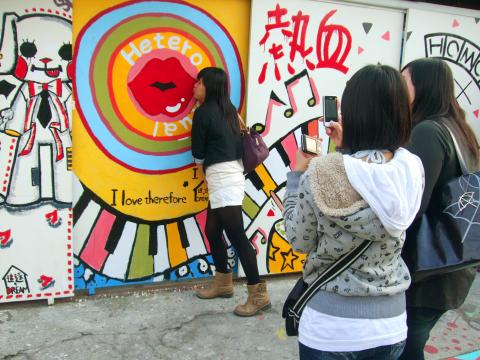Nowadays, if you ask young people in Kaohsiung where they like to go, you might be surprised. Apparently the latest “in” place to go is the Zih Jhu Military Dependants’ Village in Zuoying, to stroll around looking at the wall paintings and installation art there.
Word spread on the Internet, and it is now as well known as the Rainbow Military Dependents’ Village in Greater Taichung. During the four-day Tomb Sweeping Day vacation, students flocked in from all around the country. It was estimated that there were thousands of visitors to the village every day, making it almost as popular as the Pier-2 Art Center. People joke that you won’t get lost there, and in fact you’re more likely to get stuck in traffic.
There are still people living in the village. The sound of motorcycles roaring past and the excited shouts of teenagers taking photos around the village is disturbing the locals. Angered by the noise, the residents have taken to putting up signs saying “keep the noise down or keep away.”

Photo: Ke You-hao, Liberty Times
照片:自由時報記者葛祐豪
All this began last summer vacation when Chung Hui-jung and Huang Hsin-ying, two graduates from Wenzao Ursuline College of Languages, came to the village and lost their way. They ran into a security guard and asked him if it were ok to paint on the walls. He told them they could paint as much as they wanted, as the place was going to be torn down anyway. And that’s how it all got started.
The two girls then brought paint and improvised. They wrote about it on their blog and on Facebook, and it gradually developed a following. Students from the nearby Kaohsiung Municipal Haicing Vocational High School of Technology and Commerce joined in and started to paint the walls in the village.
The continuous flow of youngsters may have disturbed some old people’s afternoon sleep, but it also brought unexpected business opportunities to the village’s few remaining shops. The owner of a popular shop selling crispy rolls, outside which there was a long queue of customers, said that he had never seen so many young people in the village.
(LIBERTY TIMES, TRANSLATED BY TAIJING WU)
時下年輕人最夯的高雄景點在哪?答案可能跌破一堆人眼鏡,竟是左營自助新村的牆壁彩繪與裝置藝術「眷村裡迷路」。

Photo: Ke You-hao, Liberty Times
照片:自由時報記者葛祐豪
透過網路流傳,「眷村裡迷路」最近爆紅,名氣不輸台中彩虹眷村。四天清明連假,外地的學生族群慕名而來,估計每天來往的人潮至少數千人,人氣直逼駁二藝術特區,有人揶揄說「眷村裡不會迷路,但是會塞車!」
不過,自助新村目前仍有住戶,機車呼嘯而過,加上年輕人拍照時的興奮叫鬧聲,已打擾到住戶生活,氣得開始掛起「請大家輕聲細語,違者滾出去」的抗議看板。
故事的緣起是去年暑假,文藻外語學院畢業生鍾慧蓉、黃馨瑩來到自助新村,在眷村裡迷了路,遇到當地的管區員警問說:「我們可以在這裡畫畫嗎?」員警阿莎力回答:「反正這裡要拆了,儘管畫吧!」就這樣,意外開啟這段美麗的機緣。
兩名大女孩搬來油漆,開始即興彩繪創作,透過部落格和臉書,逐漸吸引年輕人目光,隔壁海青工商學生也加入行列,在眷村牆壁上塗鴉創作。
年輕人絡繹不絕,確實影響了一些老伯伯的午睡,但也為眷村裡僅剩的幾家商店帶來意外商機,一家知名的脆皮捲餅,門口排了幾十公尺長的人龍,老闆說,從沒看過自助新村湧入這麼多年輕人。
(自由時報記者葛祐豪)

Have you ever seen a circular intersection where cars continuously flow in one direction around a central island? That is a “roundabout,” a well-known alternative to traditional intersections. Drivers enter and exit at different points without relying on traffic lights. Their primary purpose is to improve traffic flow and minimize the likelihood of high-speed collisions, particularly dangerous T-bone and head-on crashes. Roundabouts have existed and been implemented for over a century. In the 1960s, the modern roundabout emerged in the UK, with added rules for yielding. Unlike intersections with red lights, roundabouts allow vehicles to continue moving at a

If you’ve recently spotted adults parading around with cuddly toys dangling from their designer handbags, your eyes haven’t been deceiving you. The playful trend of adorning bags with cute charms has become popular among people of various ages. Plushies like Labubu and anime and manga characters such as Chiikawa have become must-have accessories that make personal statements. The practice of attaching charms to personal items has been common across cultures throughout history. In ancient civilizations, charms were often used as symbols of protection, good luck, or identity. Fast-forward to more modern times, and style icons like Jane Birkin, a

A: So you’re reading Jin Yong’s martial arts novel again? B: Yup, Jin’s novels are so fascinating, especially the trilogy: “Legends of the Condor Heroes,” “Return of the Condor Heroes,” and “Heaven Sword and Dragon Saber.” A: The late novelist published his first story in 1955, which means this year marks the 70th anniversary of his “wuxia” world. B: Wasn’t an English version of “Legends of the Condor Heroes” also released in 2018? A: Yes, but the debate over the translation of kung fu moves continues — like the evil move “Nine Yin Skeleton Claw.” A: 你又在重讀金庸的武俠小說啦? B:

A: Apart from Jin Yong, the late martial arts novelists Liang Yusheng and Gu Long were also very popular. B: Wasn’t Liang a pioneer of the “new school” wuxia genre in the 20th century? A: Yup, I really like his Tianshan mountain series. All the characters — such as the “White Haired Demoness” — are so vivid. B: The roles in Gu’s books are lively, too — like the “Fragrant Commander” Chu Liuxiang. A: And the TV drama adapted from the Chu Liuxiang series swept across Taiwan in the 1980s, with ratings surging over 70 percent at that time.